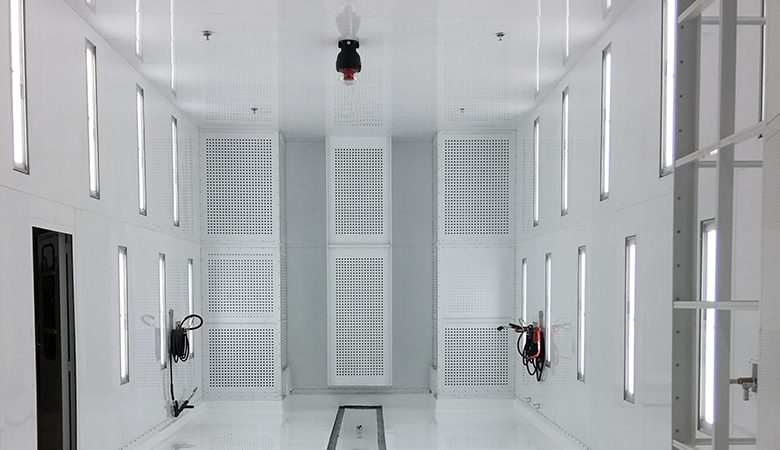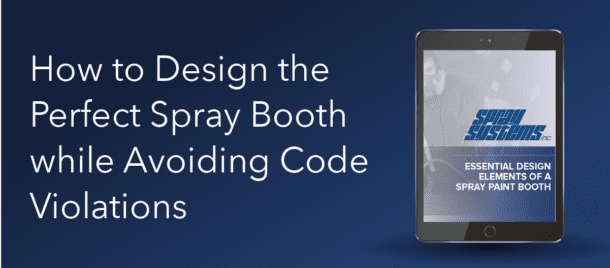Read Time: 3 minutes
Summary
- Because the chemicals used in most spray and finish applications are flammable or have toxic properties, companies considering incorporating spraying processes into their operations must adhere to applicable regulations to avoid costly fines and other penalties.
- The US Occupational Safety and Health Administration (OSHA) is the primary federal agency responsible for administering regulatory requirements regarding all aspects of spraying operations.
- OSHA regulations regarding spray operations can be broken down into a few broad categories—general industry, shipyard/marine, and construction.
- The sheer number and detail of regulations that apply to spray booth operations can make finding the right booth a real challenge; but an experienced booth designer and manufacturer can customize your booth to meet all current OSHA and state regulations based on your industry, location and production processes.
- Finding the right booth can take time and effort, but it’s a necessary step toward creating a productive, safe and environmentally responsible workplace.
The chemicals used in most spray and finish applications are flammable or have toxic properties, which means they present a serious risk to human health and the local environment. Volatile organic compounds (VOCs) are common in these mixtures and their usage is regulated at both the state and federal level. Any company considering incorporating spraying processes into their operations must adhere to applicable regulations to avoid costly fines and other penalties resulting from non-compliance.
The US Occupational Safety and Health Administration (OSHA) is the primary federal agency responsible for administering regulatory requirements regarding all aspects of spraying operations. Individual state governments also create their own laws that meet the minimum regulations established by OSHA, but they can also have additional or more stringent rules for companies operating within their jurisdiction. The following is a discussion of OSHA and not meant to replace the guidelines as described by OSHA (see OSHA link for complete understanding of all OSHA requirements).
What is the Purpose of OSHA Standards?
OSHA was founded as a federal agency with the passage of the Occupational Safety and Health Act of 1970. Its mission is to ensure the “safe and healthful working conditions” of employees and the general public by setting standards for industrial manufacturers and other businesses. These rules are developed and refined on a regular basis, so operators and spray booth manufacturers need to stay informed to ensure full compliance.
It’s also important to note that adhering to these regulations can have significant benefits for employers aside from compliance. Prioritizing human safety and health is essential for creating a friendly and productive work environment. Less incidents means lower liability from worker’s compensation or legal claims, which can also translate into better brand image with the general public.
Rules that Apply to Spray Booths
OSHA regulations regarding spray operations can be broken down into a few broad categories:
- General Industry
- Shipyard and Marine
- Construction
General Industry
The general industry section of the OSHA regulations, Part 1910 of the official standards, contains rules that apply to almost any kind of spray or finish operation. It includes the fundamentals of worker safety, hazardous material containment and ventilation requirements. Many of the topics discussed in this portion of the rules are also covered or developed further in the construction industry section.
This section defines the scope of acceptable equipment for eye, face, skin and respiratory protection for workers participating in spray operations. The ventilation requirements are also particularly important for booth manufacturers and operators because they establish several key parameters that influence the system’s overall design, installation, and maintenance.
Shipyard and Marine
There are a few portions of the shipyard employment, marine terminals and longshoring sections that can also affect spray booth operators. These sections include special considerations that arise from proximity to a marine environment or shipyard. For example, the marine terminals section of the OSHA standards prohibits spray operations within the vicinity of cargo handling operations. Some coastal areas also have additional environmental protection laws to protect native wildlife or water quality.
Construction
Spray booth designs need to account for the ventilation regulations described in the construction industry section of the standards. This section also covers the containment of certain types of common hazardous compounds, including lead and cadmium. Subpart F includes measures regarding fire protection and prevention, which is a serious concern in any kind of spray or paint application.
How to Ensure Booth Compliance
The sheer number and detail of regulations that apply to spray booth operations can make finding the right booth a real challenge. Maintaining compliance is a top priority for businesses, so booths should be tailored to meet all current OSHA and state regulations based on the industry, location and production processes. For many operators, finding an experienced booth designer and manufacturer is a better choice than purchasing a spray booth that under-performs and under-protects.
As a designer and manufacturer of custom booths, Spray Systems, Inc. offers in-depth consultation with customers to explore the various advanced design solutions that appropriate for you. We help buyers identify regulations that could impact their workplace and provide insight into the value offered by each type of design. Finding the right booth can take time and effort, but it’s a necessary step toward creating a productive, safe and environmentally responsible workplace. Contact our experts for help with your booth.



